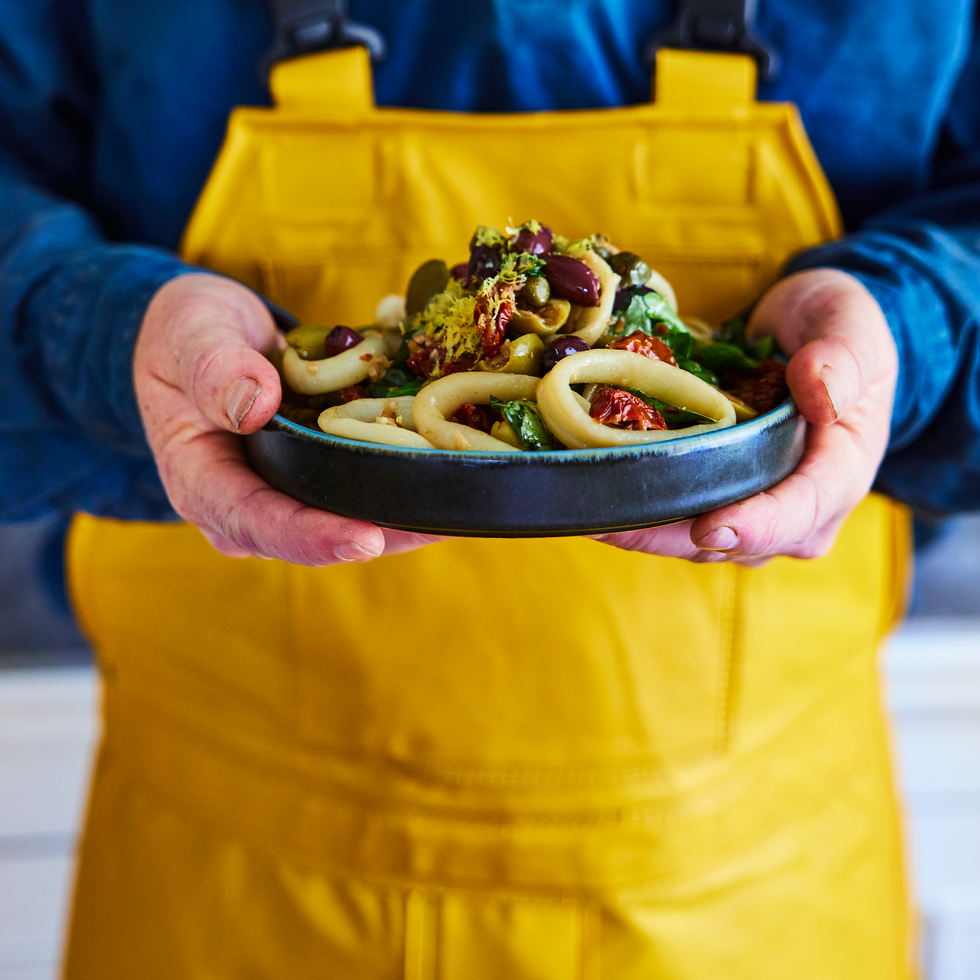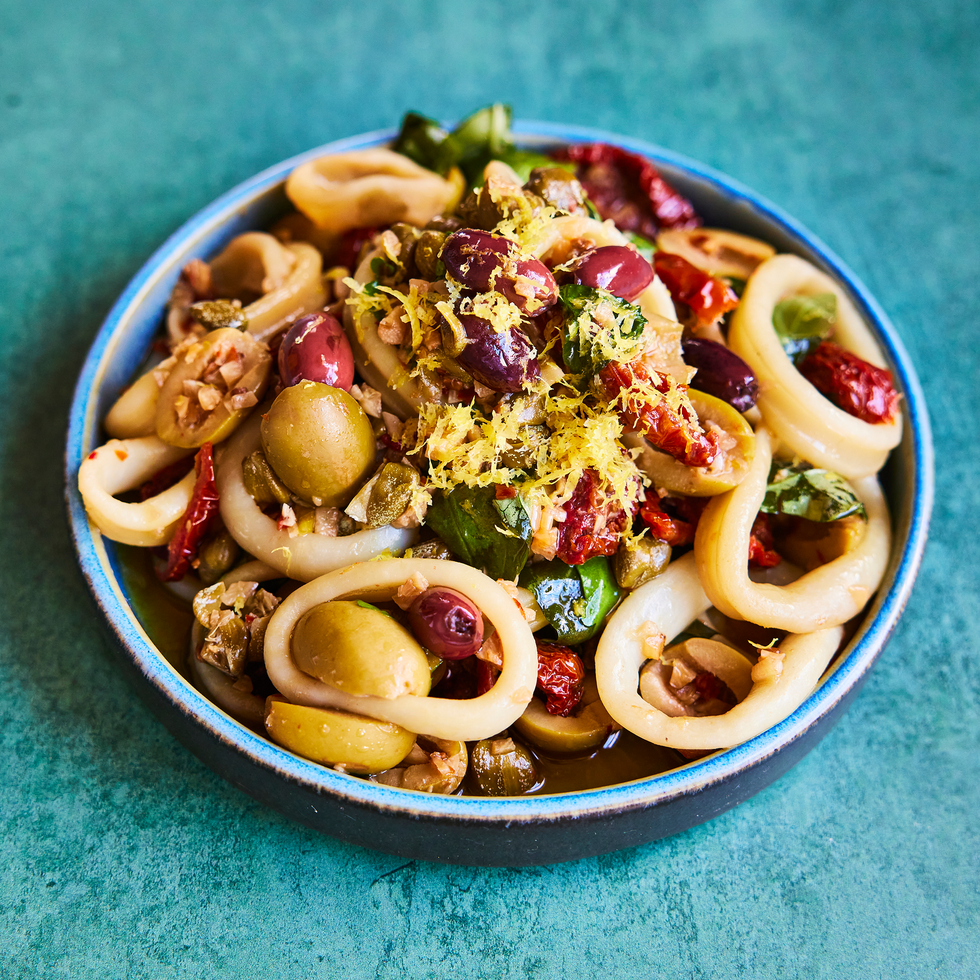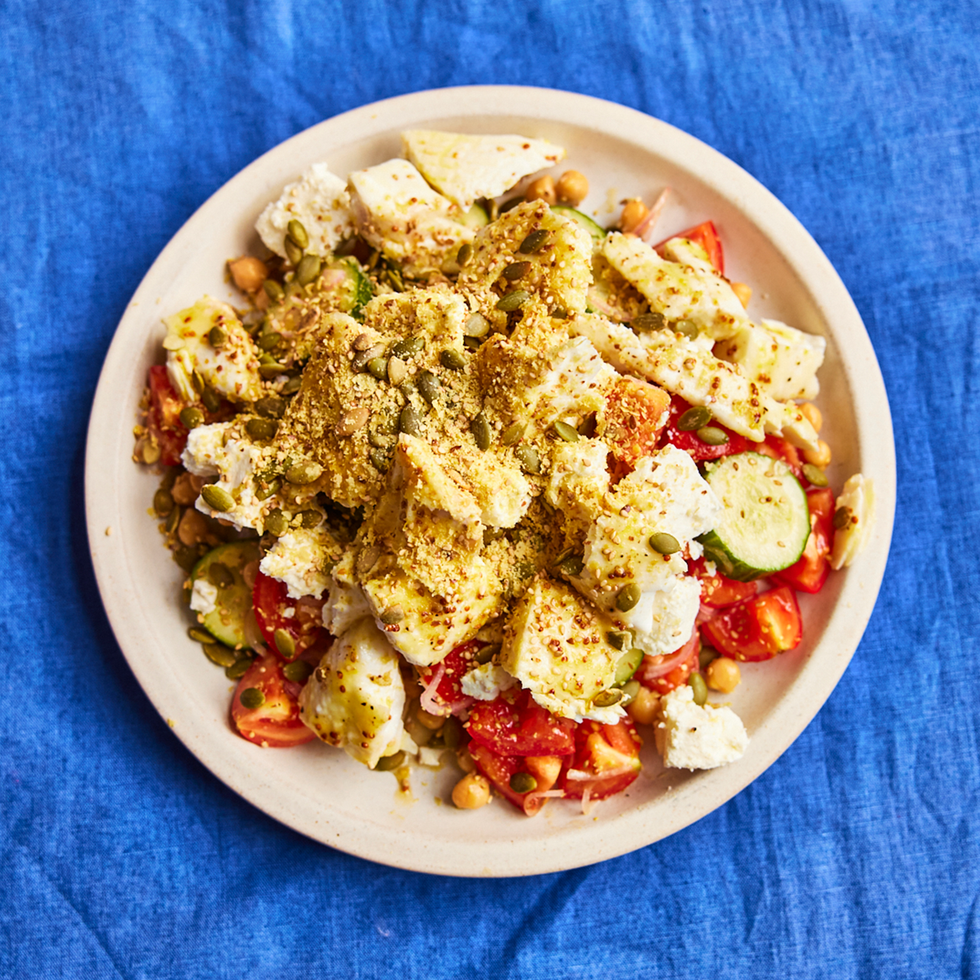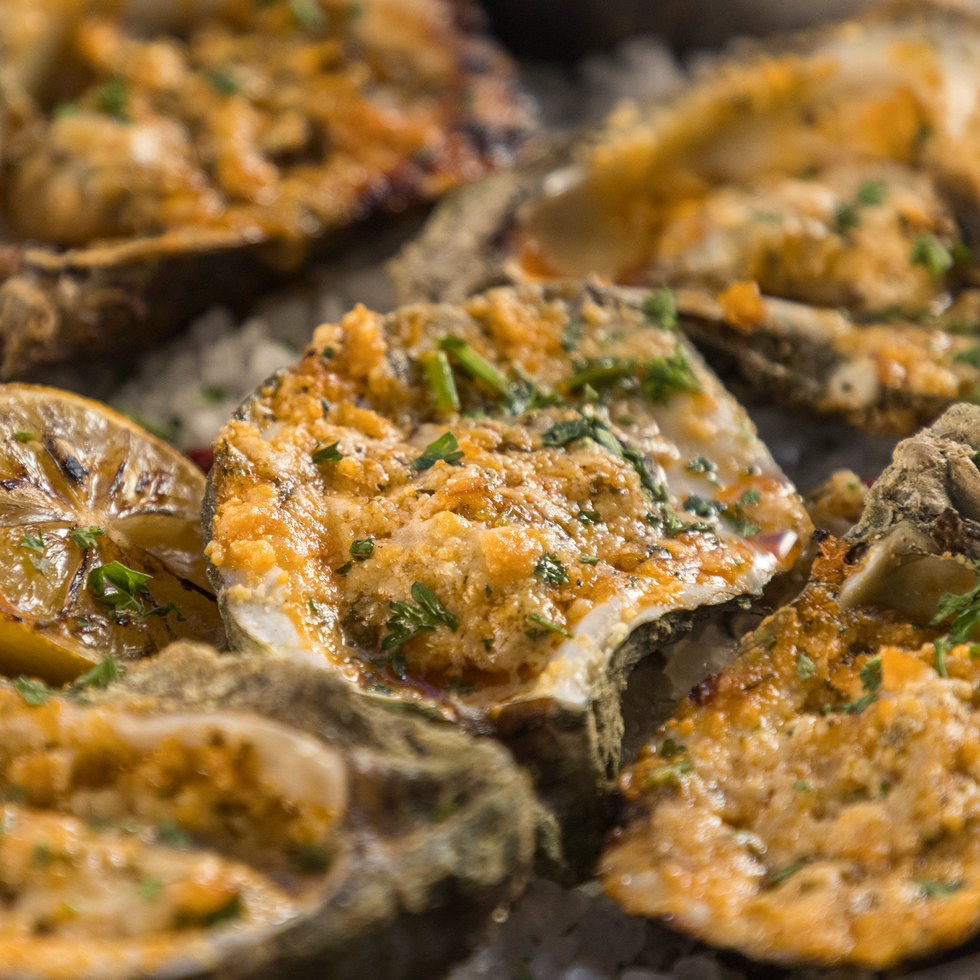
We all know that seafood has special superpowers when it comes to our health, especially our heart health, but finding seafood that is also healthy for the planet is a little trickier. Good news: The Marine Stewardship Council (MSC), a mission-driven, nonprofit organization, makes it so easy to choose seafood that is good for you *and* our oceans. Just look for the MSC blue fish label, a bright blue label you can find on wild-caught seafood in popular grocery stores and online retailers like Aldi, Amazon Fresh, Costco, and Whole Foods. Catch the label on fresh, frozen, or canned seafood and you know you're making a more sustainable choice. Even your fur babies can enjoy MSC-certified sustainable pet food!
We chatted with Carrie Walder, MS, RD, a notable registered dietitian, to learn how seafood can impact our brain and mental health as well as our immune systems. Walder also shared how sustainable seafood can fit within any budget and the best ways to serve it for the most nutritional punch. Cod, salmon, halibut, mackerel, squid, oysters…anyone else hungry? We’ve got you. Scroll down for three delicious recipes from the new MSC cookbook, The Ocean Cookbook 2022, perfect for a heart-healthy *and* ocean-friendly Valentine's night in!

What are the health benefits of eating seafood?
Many know that seafood is a heart-healthy food, but it's also a really important brain food. Seafood is a source of healthy unsaturated fats, like omega-3s, especially one called DHA, which is very present in the membranes of our brain tissues, required for normal, healthy brain functioning. Seafood is not only a quality protein source, it's also a source of a ton of different micronutrients, like selenium, iron, and vitamin D, plus it has lots of B vitamins.
Is there a limit to how much we can eat each week?
The 2020-2025 Dietary Guidelines for Americans (a bit of a mouthful!) recommends eating at least eight ounces of seafood a week. It’s not always clear what eight ounces really means, so I like to say that if you eat two standard salmon filets or have a combination of a salmon filet and a serving of canned tuna, you’ll hit the right amount.
How can we be more responsible seafood eaters?
By always trying to make sure that we purchase seafood that's both good for us and for the ocean as well. One of the easiest ways to do this is to look for that MSC blue fish label on seafood products so that you know that you're really choosing seafood that is environmentally sustainable. And we're really lucky that it's actually really easy to identify that label. It's a bright blue label. It's on different kinds of seafood at the fresh counter, in the freezer section, the canned aisle in the grocery store as well as lots of different grocery stores, including Lidl, Sam’s Club, Stop & Shop, Target, Walmart, and more.
Top of mind right now, how can seafood impact our immune system?
The food that we eat can provide all the nutrients that our immune system needs to function properly. Protein, for instance, helps us to create those antibodies that help to fight off foreign invaders, like bacteria and viruses. It also plays that really essential role in recovery and healing. Different vitamins like vitamin B12, C, D, A, as well as minerals like zinc, iron, and selenium work in so many different ways to support our immune function. They help build those immune cells. They can help protect our immune cells from oxidative damage because a lot of them have antioxidant functions as well. And the great thing about seafood is that it happens to have so many of these nutrients. It’s really the complete package.
What about the impact seafood can have on our mental health?
There are so many factors that play a role in our mental health. Some of them are very much not in our control, but food and nutrition does appear to play a role. It is still a developing area of research, but there is some evidence to point toward a more Mediterranean-style diet. Fish is a big part of a Mediterranean diet and while the mechanisms are not super well understood yet, a lot of the research is looking at the omega-3 content in fish and seeing if there is a link between a regular intake of omega-3s and managing certain mental health disorders, like depression. Some studies have shown that eating about two to three servings of fish per week, or those omega-3 supplements, really can help to reduce depression.
What are healthy ways to cook fish?
I love avocado oil. It's got those monounsaturated, fatty acids in it. It's very healthy and it has a very neutral flavor. I love preparing seafood by either baking it in an oven or poaching it. I recently prepared this squid puttanesca in MSC's The Ocean Cookbook 2022. I really liked serving it over quinoa, but you can do it over another whole grain, like farro or a whole wheat pasta, to really compliment the protein and healthy fat in the dish.
Food pairings, in fact, can enhance the nutrition factor. What sides do you recommend to get the most out of the nutritional benefits of seafood?
Some studies have found that animal proteins, like sustainably caught seafood, can help increase the absorption of zinc from plant-based foods, like whole grains, legumes, and seeds. The vitamin D that's present in seafood can help increase the absorption of magnesium. The healthy fats that are in seafood can also help us absorb fat-soluble vitamins that are present in the rest of the meal; for example, putting nuts and seeds on a halibut salad or having a shrimp stir-fry with full grains, or I like to add a seed or nut crust on a baked fish. There are so many opportunities.
What if you're on a budget? How can you enjoy more seafood?
It's totally possible. Frozen seafood is a really great affordable option that also provides the same health benefits as fresh fish. And because you can keep it in the freezer, there's less chance of food waste. Canned seafood is another really great budget-friendly option. There are so many different varieties of fish that you can get canned. I personally really love canned mackerel to switch things up from canned tuna. And then I suggest regularly checking your grocery store to see what's on sale. It's important to remember that frozen and canned seafood are just as nutritious as fresh. The nutrients are very much preserved during the immediate freezing and processing of the seafood.
That’s really good to know! Speaking of food waste, what are some ways to reuse your leftover fish?
This is one of my favorite topics, because sometimes we have leftover fish, say salmon, and then we reheat it in the microwave, but it's not as good as it was when it was fresh. One way to address this is to chop up those leftover filets of fish and repurpose them in different dishes. It really takes away from those changes in texture and gives you a completely different meal, which can really combat that leftover fatigue. Some of my favorite ways to do this are to use it cold and add it to salads, grain bowls, or tacos. I like to mash up leftover fish with avocados, some lemon, some chopped parsley and dill, and then add it to whole grain toast or an open-face sourdough toast. You can add leftover fish to warm dishes like pastas, stir-fry's, or quesadillas, even a seafood chowder. Eggs are a really great way to use leftover seafood. Put it in a frittata or scrambled eggs. And I really like that when you’re repurposing your leftover fish, you're helping to reduce food waste. That kind of goes hand in hand with protecting the planet. And if we're choosing the MSC-certified sustainable wild-caught seafood, it really takes that one step further.
Thanks so much Carrie! What great information, and we’ll be sure to look out for the MSC blue fish label. Now we’re hungry. Check out these easy and delicious (and totally sustainable) recipes from MSC's The Ocean Cookbook 2022.
Squid Puttanesca

Recipe by Chef Gregory Gourdet,
“Top Chef” All Star and MSC US Ambassador”
Serves 4 to 6
INGREDIENTS
- 1lb squid rings and tentacles, thawed and blotted dry on towels
- ¾ cup extra-virgin olive oil
- ½ teaspoon plus 1 pinch of kosher salt
- 10 large cloves garlic, finely chopped
- ¾ cup drained oil-packed roasted or sun-dried tomatoes, halved
- ½ cup pitted mixed olives, large ones halved
- 3 tablespoons drained capers
- 1 teaspoon red chili flakes
- Large handful basil leaves, torn
- Small handful small parsley sprigs
- 1 juicy lemon, whole
DIRECTIONS
- Heat the olive oil in a large skillet over medium heat until it shimmers.
- Add the garlic and a pinch of salt and cook until the garlic is golden, about 2-3 minutes.
- Add the tomatoes, olives, capers, and chile flakes and cook, stirring occasionally, just until it’s all warmed through, 2 to 3 minutes.
- Season the squid with the remaining salt.
- Add the squid to the pan and cook all, mixing occasionally until the squid is firm but still tender to the bite, about 3-4 minutes.
- Add the basil and parsley, use a Microplane to grate in the lemon zest, then halve the lemon and squeeze in half the juice.
- Stir really well and transfer to a platter to serve. Serve warm or room temperature.
Roasted and Flaked Wild Halibut Salad with Crunch Seed Topper

Recipe by MSC Chef Ambassador Charlotte Langley,
Chief Culinary Officer of Scout Canning, Canada
PREP TIME: 30 minutes
COOK TIME: 15-30 minutes
Serves: 4 for lunch or a light supper
INGREDIENTS
- 225 g (½ lb) fillet of MSC certified halibut
- 200 g (1 c) cucumber, sliced in thick rounds
- 180 g (1 c) tomatoes, coarsely chopped
- 1 shallot, thinly sliced • 400 g (1 can, approx. 14 oz) canned chickpeas, drained and rinsed
- 110 g (½ c) fresh goat feta cheese, crumbled
- 120 ml (½ c) olive oil
- 30 g (2 tbsp) grainy mustard
- 30 g (2 tbsp) honey, runny
- 60 ml (¼ c) lemon juice
- Salt & pepper, to taste
CRUNCHY SEED TOPPER :
- 20 g (4 tbsp) toasted pumpkin seeds
- 25 g (2 tbsp) white sesame seeds
- 12 g (1 tbsp) flax meal or seeds
- 20 g (4 tbsp) nutritional yeast or grated parmesan
DIRECTIONS
- Preheat the oven to 190 ºC / 375°F. Line a cookie sheet with parchment and place your halibut on the sheet pan. Season with salt and pepper. Bake in the oven for 20-25 minutes or until the halibut has reached an internal temperature of 48 ºC / 120°F or is no longer opaque in the center.
- In a small bowl, whisk together all the dressing ingredients and set aside in the fridge.
- In a medium bowl, combine all the vegetables and chickpeas and dress with half of the dressing. Season and let it sit in the fridge or at room temperature for at least 15 minutes.
- Remove the halibut from the oven, pour the rest of the dressing over it, and let it rest for a few minutes. While the fish rests, combine the ingredients for the crunchy seed topper and set aside.
- To serve: Tear the halibut into large flakes. In a large family-style serving platter or individual bowls, plate the salad, the halibut flakes, and sprinkle with the goat feta and the crunchy seed topper. Serve at your leisure.
Grilled Parmesan Garlic Oysters

Recipe by Chef Joe Cervantez at Prestige Oysters, MSC-certified oyster fishery
PREP TIME: 10 minutes
COOK TIME: 15 minutes
Serves: 4
INGREDIENTS
- 12 Oysters, on the half shell
- 3 oz Shallots, minced
- 3 oz Garlic, minced
- 3 oz Parmesan cheese, grated, plus extra for topping
- 2 tbsp Worcestershire sauce
- 1 tsp Salt
- 2 lemons, juiced
- 1 lb unsalted butter
- Blend all ingredients together, except for the oysters, to create a flavored butter.
- Top each oyster with the butter. Grill oyster (over open fire, on a gas burner, or any outdoor grill) for 15 minutes. You will see the oysters bubble.
- Remove from heat, finish with extra parmesan cheese, and serve.

What are you cooking this Valentine's Day? Share with us @BritandCo!
In partnership with The Marine Stewardship Council (MSC)
Main image: Anthony J Rayburn, courtesy of the Marine Stewardship Council
0 Commentaires